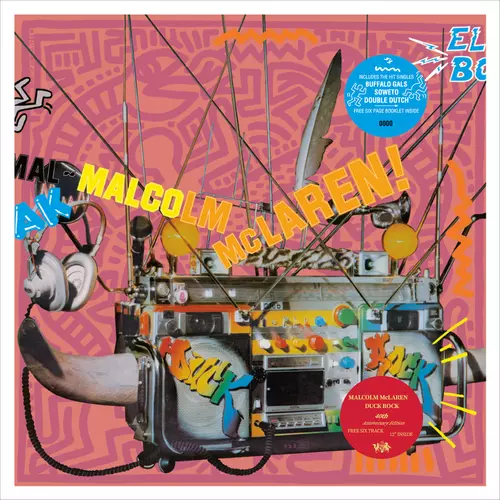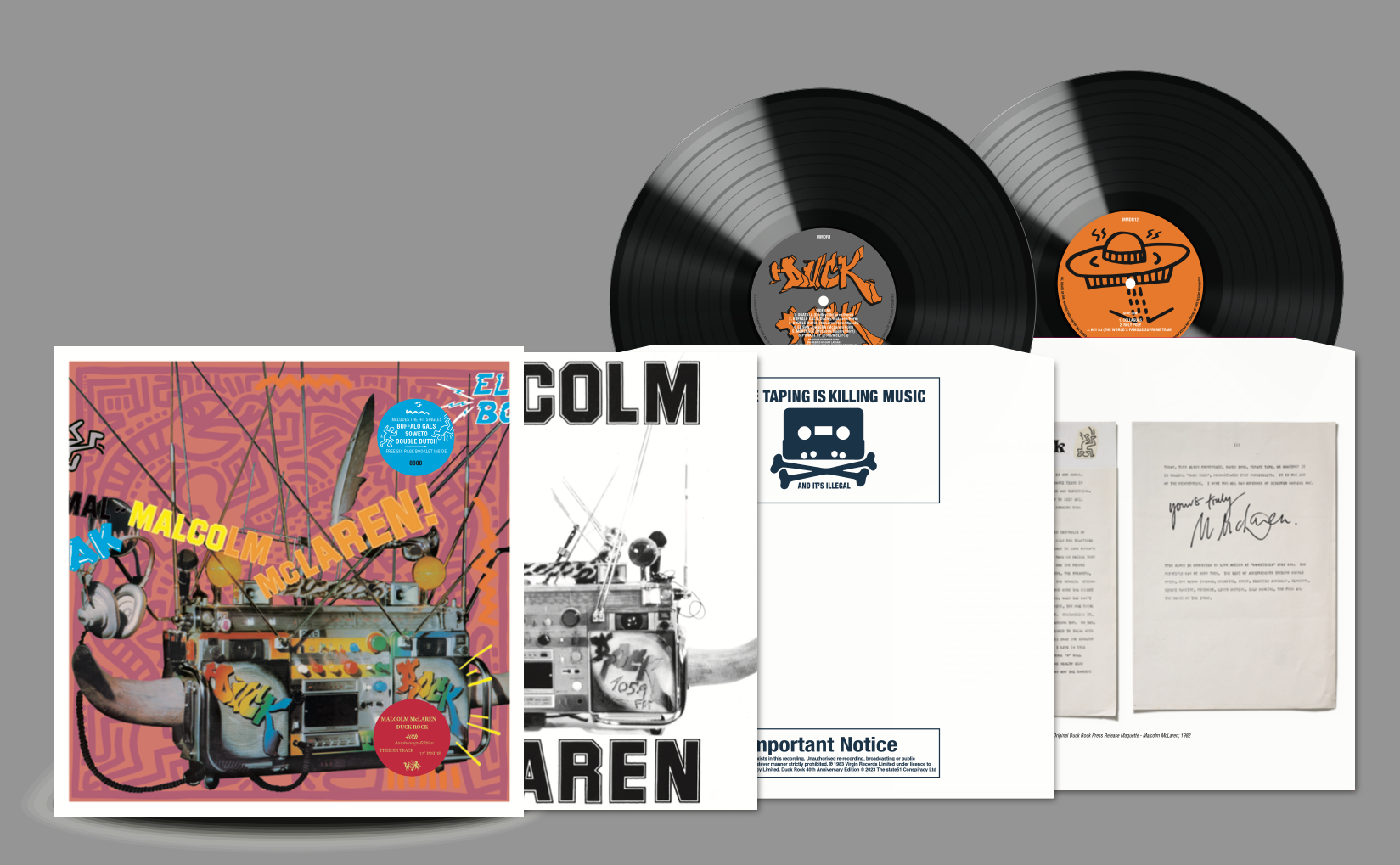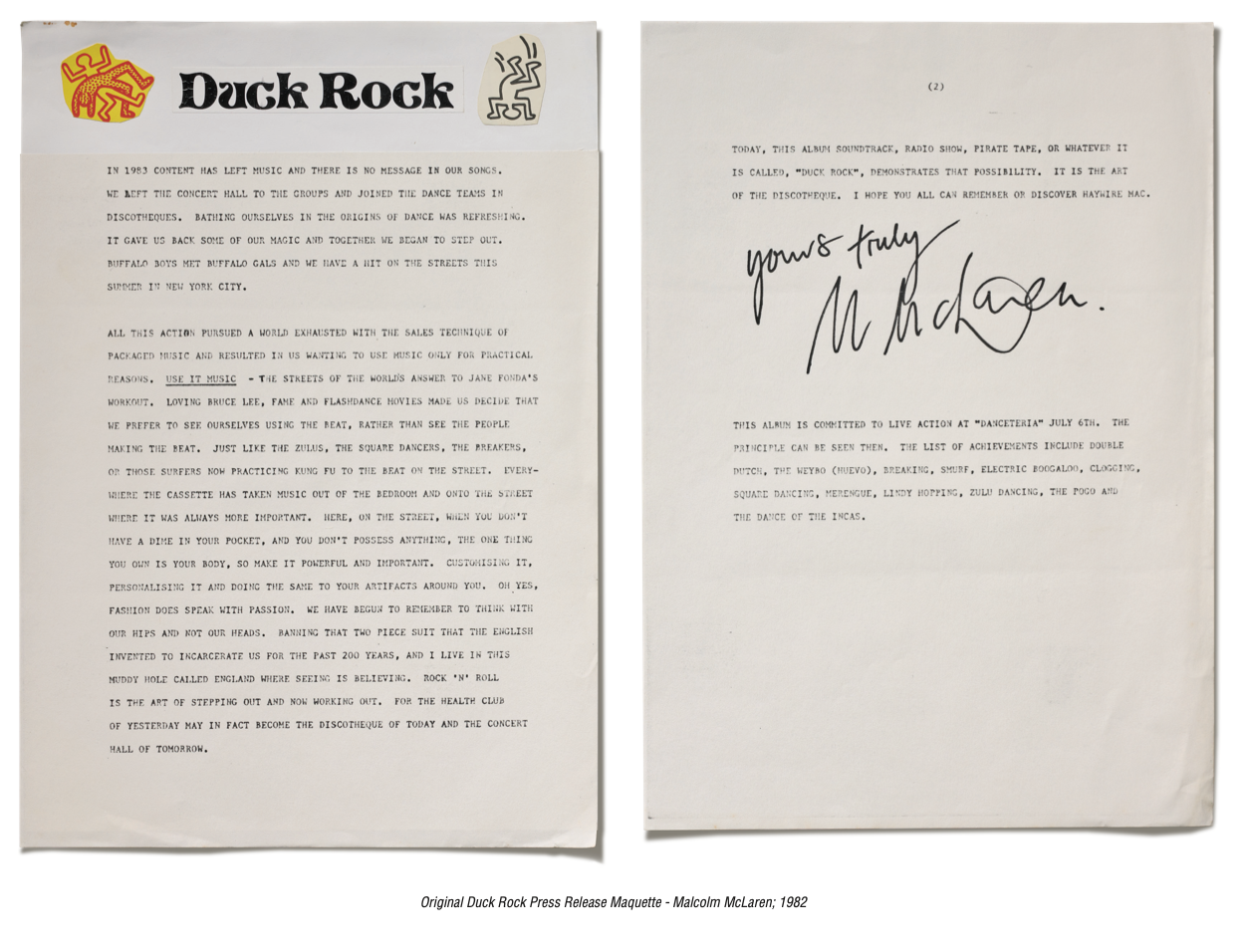
Duck Rock
Malcolm McLaren
| Formats | Tracks | Price | Buy |
|---|---|---|---|
| 12" Vinyl Album (40th Anniversary Edition) | 18 tracks | £35.99 |
Description
Malcolm McLaren - Duck Rock

It seems extraordinary to think that the architect of punk was at the vanguard of another youth movement that has proven to be even more significant. Few ever doubted that Malcolm McLaren was a visionary, though somehow with each passing year, his debut album Duck Rock sounds more timely, more fresh and more original than ever. He not only helped to usher in hip hop in the UK, but he was at the forefront of what would become World music too, and perhaps most presciently of all, he paved the way for the omnipresent cut-up culture of the 21st century which really began with Dada.
The roguish impresario had wanted to reissue Duck Rock in 2008 to mark its 25th anniversary. Sadly that didn’t come to pass, though this 40th anniversary double vinyl edition feels not only apposite to 2023, but its energy and ebullience is a much needed shot in the arm. Released by the state51 Conspiracy in collaboration with McLaren’s widow Young Kim, it features material that never made the original album: songs like ‘Zulus On A Time Bomb’ have been brought back into the fold, while ‘Collaguas’ and ‘Roly Poly’ give an insight into the scale and haphazard nature of the project. There’s even a ‘Take Me Out’ mashup called ‘Franz Buffalo’. Furthermore, the artwork has been pristinely and painstakingly reconstructed under the watchful eye of the original graphic designer Nick Egan, bringing out the fluorescents of Keith Haring’s immediately identifiable motifs.
McClaren had already dabbled in polyrhythms after coming across field recordings of Burundi drummers at the Beaubourg’s library in Paris in the late seventies - a secret rhythmic language he bestowed unto Adam and the Ants and Bow Wow Wow, leading to chart infamy for both acts and the New York Times dubbing it The New Tribalism. Now he was going to do more than just dabble, an outsider artist making a collage with the variegated sounds from Planet Earth. No genre was safe, from square dancing to the merengue, from turntablism to the township jive.
“Having been responsible for an earlier DIY culture, I couldn’t help feeling that I would be unquestionably a fraud if I didn’t attempt to do it myself,” wrote McLaren for the original sleeve notes for the aborted 25th anniversary edition. “So I stepped out from behind the curtain, signed with Charisma records, and set off to make this album in 1981.”
It was a trip to New York and an excursion to see Afrika Bambaataa playing a block party in the Bronx that provided the real epiphany. Rather than lick his wounds from the fallout of the Sex Pistols, Malcolm envisaged bringing the Appalachian Mountains to the South Bronx and taking the b-boy electro of Zulu Nation to Kwazululand and Soweto, and then round the outside again. It was an audacious undertaking, long before the awesome reach of the internet enabled you to access sounds from everywhere at the push of a button. To seek out the musicians he needed, McLaren would have to go to them.
Like a sonic antiquarian, he collected banjo players and violinists from the Deep South, Peruvian panpipers, Colombian marching bands and Dominican bakers and mechanics who also played a mean merengue. The beat of Soweto underpins four songs on the album, while three songs are named after Afro-Cuban deities. And then there are segues from track to track, overseen by New Jersey’s finest the World Famous Supreme Team, inventing the mixtape into the bargain.
McLaren was responsible for the UK’s first ever hip hop single with ‘Buffalo Gals’ in 1982, with a little help from Trevor Horn, Anne Dudley and the aforementioned WFST. The accompanying video, recorded in New York, opened the possibilities of scratching and street dancing to kids everywhere (except America, as MTV refused to play it). “We got to see body popping for the first time, break dancing for the first time, kids putting lino on the pavement, the graffiti writers and the DJs,” Rodney P told Vinyl Factory in 2015. “All the elements were there. Malcolm McLaren was a big part of the UK hip hop story, though he’s often written out of it.”
Mclaren saw how the South Bronx was going to influence South London. He told Neil Tennant at Smash Hits: “These are the people I can very easily see getting hold of their brother’s or mother’s record players and fitting them up and piling up a load of records and figuring out what’s a good groove and a good beat. Suddenly a whole different attitude will take place. Live discotheques where DJs will be grooving along to their favourite records with their friends coming in to give them a hand, scratching one record into another.”
‘Buffalo Gals’ would go on to directly influence everyone from Herbie Hancock, who wrote ‘Rockit’ after hearing it, and Neneh Cherry, who’s ‘Buffalo Stance’ sampled the track and made it to no.3 on both sides of the Atlantic. McLaren was no one hit wonder either. The sonic rush that is ‘Soweto’ reached the top 40 and the transcendent ‘Double Dutch’ was a bigger hit even than ‘Buffalo Gals’. Let’s conclude with the words of McLaren himself, who in 2008 wrote: “Enjoy it all! It sounds better than it did on that June day 1983 when it was first released. I have to thank Trevor Horn, Gary Langan, Anne Dudley and the World’s Famous Supreme Team for keeping the faith even when it was tough for some of them to do so. This record is a masterpiece of pop culture. A true milestone in pop history.”

Notes on the record
Overall there was no original mechanical artwork to be found. The artwork was rebuilt by Daniel Mason at Something Else from 1983 release copies, miscellaneous scans and conversations with the original designer Nick Egan and the knowledge of Young Kim. The outer sleeve has been printed on a thicker than standard board and the original fluorescent details have been retained. The 6pp insert has been printed on a thick uncoated paper unlike the original that was supplied on a thin coated paper.
The intention is to offer a more elevated package to reflect the gravity of this album
These sources were not adequate to make the task simple and up to 5 retouchers were employed to complete new artwork. As an example the Duck Rock centre labels had to be completely redrawn with the team referring to a photograph as the only source
The original outer sleeve had typographic elements printed in day-glo colours. Given the above absence of artwork assets these elements have been printed as close as possible to fluorescents
The background to the front and back covers has been enhanced and brightened to the instruction of Nick Egan who wished them to be more vivid when the sleeve was originally printed
Both the front and back cover designs have been placed within a 10mm border. This is intentional and serves to celebrate the original design and to offer a new reading of this sleeve. As the design appeared on the spine of original copies these elements have been painstakingly moved back onto the front and back covers as it appears on the anniversary release
The employment of the HOME TAPING IS KILLING MUSIC icon was deliberate as this was how copies were sleeved originally. "Home Taping Is Killing Music" was the slogan of a 1980s anti-copyright infringement propaganda campaign by the British Phonographic Industry (BPI). With the rise in cassette recorder popularity, the BPI feared that the ability of private citizens to record music from the radio onto cassettes would cause a decline in record sales.
An early proponent of home taping was Malcolm McLaren who was at the time managing Bow Wow Wow. In 1980 the band released the world's first cassingle "C·30 C·60 C·90 Go" on a cassette that featured a blank B-side on which the buyer could record their own music. However, the band's record label, EMI, dropped the group shortly afterwards because the single allegedly promoted home taping
The sleeve reverse includes an extensive text by Malcolm McLaren which was transcribed in 2008. Title The Making Of Duck Rock it goes into extensive detail about Duck Rock’s genesis, development and subsequent effect on music and popular culture
The bonus 12” record is sleeved more formally in a coated board sleeve. This is intended to provide a separation between Duck Rock and the other tracks that have been remastered for this anniversary release. An image of the Duck Rock manifesto (type written by Malcolm McLaren at the time of the 1983 release) is printed to one face and presages the page layout of a book accompanying a more elevated boxed edition due later in 2023
The bonus 12” centre labels borrow elements from the 6pp leaflet along with inverting the colorways of the Duck Rock centre labels
The album will be housed in a cellophane bag to which 2 Hype stickers are attached. Hype stickers are the cover stickers that record companies use to highlight specific tracks on an LP or to draw attention to other attributes. The Blue Hype sticker is a facsimile of the label adhered to copies of the original release. For the anniversary edition this will be sequentially numbered for the first pressing. The other hype sticker follows the design tropes of the South African pressing of Double Dutch
The catalogue numbering makes a nod to the original release catalogue numbering for both the LP and the 12” bonus record.

Reviews
“Enjoy it all! It sounds better than it did on that June day 1983 when it was first released... This record is a masterpiece of pop culture. A true milestone in pop history.” - Malcolm McLarenTracklisting
12" Vinyl Album (40th Anniversary Edition) (MMDR1)
- Obatala
- Buffalo Gals
- Double Dutch
- El San Juanera
- Merengue
- Punk It Up
- Legba
- Jive My Baby
- Song For Chango
- Soweto
- World's Famous
- Duck For The Oyster
- Collaguas
- Roly Poly
- Hey DJ (7" Version)
- Zulu’s On A Time Bomb
- D’Ya Like Scratchin’ (Special Version)
- Franz Buffalo